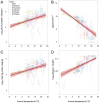Anthropogenic climate change is worsening North American pollen seasons
- PMID: 33558232
- PMCID: PMC7896283
- DOI: 10.1073/pnas.2013284118
Anthropogenic climate change is worsening North American pollen seasons
Abstract
Airborne pollen has major respiratory health impacts and anthropogenic climate change may increase pollen concentrations and extend pollen seasons. While greenhouse and field studies indicate that pollen concentrations are correlated with temperature, a formal detection and attribution of the role of anthropogenic climate change in continental pollen seasons is urgently needed. Here, we use long-term pollen data from 60 North American stations from 1990 to 2018, spanning 821 site-years of data, and Earth system model simulations to quantify the role of human-caused climate change in continental patterns in pollen concentrations. We find widespread advances and lengthening of pollen seasons (+20 d) and increases in pollen concentrations (+21%) across North America, which are strongly coupled to observed warming. Human forcing of the climate system contributed ∼50% (interquartile range: 19-84%) of the trend in pollen seasons and ∼8% (4-14%) of the trend in pollen concentrations. Our results reveal that anthropogenic climate change has already exacerbated pollen seasons in the past three decades with attendant deleterious effects on respiratory health.
Keywords: Earth system model; attribution; climate change; detection; respiratory health.
Copyright © 2021 the Author(s). Published by PNAS.
Conflict of interest statement
The authors declare no competing interest.
Figures



Similar articles
-
Recent warming by latitude associated with increased length of ragweed pollen season in central North America.Proc Natl Acad Sci U S A. 2011 Mar 8;108(10):4248-51. doi: 10.1073/pnas.1014107108. Epub 2011 Feb 22. Proc Natl Acad Sci U S A. 2011. PMID: 21368130 Free PMC article.
-
Climate change, air pollution, pollen allergy and extreme atmospheric events.Curr Opin Pediatr. 2023 Jun 1;35(3):356-361. doi: 10.1097/MOP.0000000000001237. Epub 2023 Mar 14. Curr Opin Pediatr. 2023. PMID: 36917187 Review.
-
Airborne pollen trends in the Iberian Peninsula.Sci Total Environ. 2016 Apr 15;550:53-59. doi: 10.1016/j.scitotenv.2016.01.069. Epub 2016 Jan 22. Sci Total Environ. 2016. PMID: 26803684
-
Temperature-related changes in airborne allergenic pollen abundance and seasonality across the northern hemisphere: a retrospective data analysis.Lancet Planet Health. 2019 Mar;3(3):e124-e131. doi: 10.1016/S2542-5196(19)30015-4. Lancet Planet Health. 2019. PMID: 30904111
-
Climate Change and Pollen Allergy in India and South Asia.Immunol Allergy Clin North Am. 2021 Feb;41(1):33-52. doi: 10.1016/j.iac.2020.09.007. Immunol Allergy Clin North Am. 2021. PMID: 33228871 Review.
Cited by
-
Common Pollen Modulate Immune Responses against Viral-Like Challenges in Airway Coculture Model.J Immunol Res. 2023 Nov 6;2023:6639092. doi: 10.1155/2023/6639092. eCollection 2023. J Immunol Res. 2023. PMID: 37965270 Free PMC article.
-
Medium-Term Increases in Ambient Grass Pollen Between 1994-1999 and 2016-2020 in a Subtropical Climate Zone.Front Allergy. 2021 Aug 5;2:705313. doi: 10.3389/falgy.2021.705313. eCollection 2021. Front Allergy. 2021. PMID: 35387005 Free PMC article.
-
Long-Term Pollen Monitoring in the Benelux: Evaluation of Allergenic Pollen Levels and Temporal Variations of Pollen Seasons.Front Allergy. 2021 Jul 8;2:676176. doi: 10.3389/falgy.2021.676176. eCollection 2021. Front Allergy. 2021. PMID: 35387026 Free PMC article.
-
Advocating for planetary health is an essential part of advocating for children's health.Pediatr Res. 2024 Nov;96(6):1494-1502. doi: 10.1038/s41390-024-03665-8. Epub 2024 Nov 8. Pediatr Res. 2024. PMID: 39516572 Review.
-
Broussonetia papyrifera Pollen Metabolome Insights, Allergenicity, and Dispersal in Response to Climate Change Variables.Metabolites. 2025 Feb 18;15(2):137. doi: 10.3390/metabo15020137. Metabolites. 2025. PMID: 39997762 Free PMC article.
References
-
- Field C. B.et al. ., IPCC, 2014: Climate change 2014: Impacts, adaptation, and vulnerability. Part A: Global and sectoral aspects. Contribution of working group II to the fifth assessment report of the Intergovernmental panel on climate change (Cambridge University Press, Cambridge, UK and New York, NY, 2014).
-
- Haines A., Kovats R. S., Campbell-Lendrum D., Corvalán C., Climate change and human health: Impacts, vulnerability and public health. Public Health 120, 585–596 (2006). - PubMed
-
- Watts N., et al. , The lancet countdown on health and climate change: From 25 years of inaction to a global transformation for public health. Lancet 391, 581–630 (2018). - PubMed
-
- Ariano R., Canonica G. W., Passalacqua G., Possible role of climate changes in variations in pollen seasons and allergic sensitizations during 27 years. Ann. Allergy Asthma Immunol. 104, 215–222 (2010). - PubMed
Publication types
MeSH terms
LinkOut - more resources
Full Text Sources
Other Literature Sources
Medical
Miscellaneous

